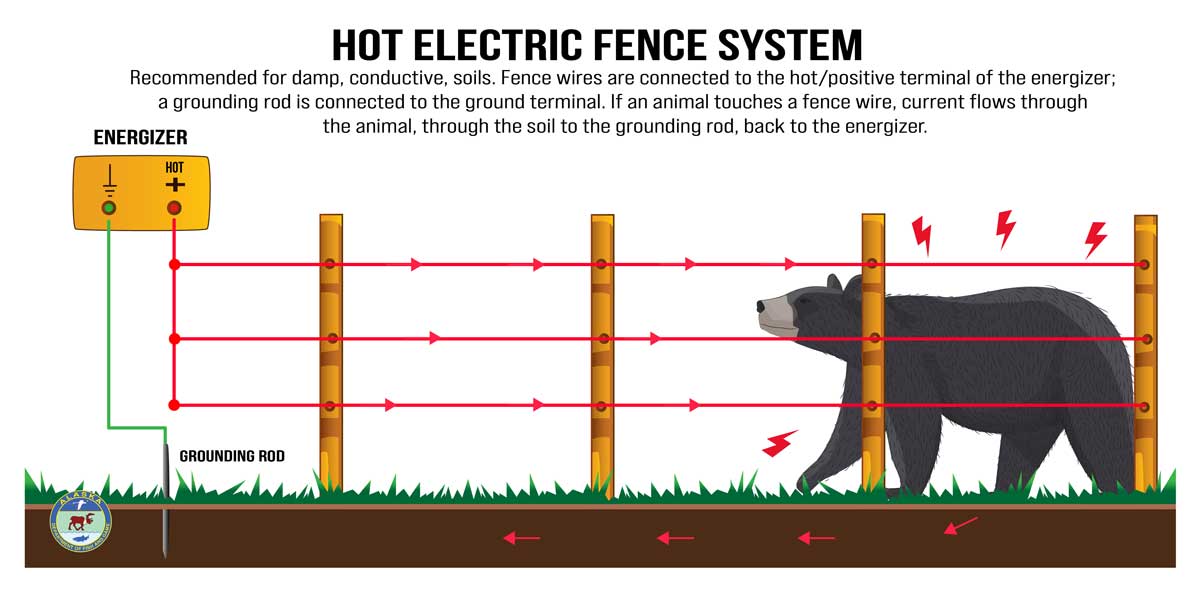Electric Fences as Bear Deterrents
How Electric Fences Work
All fences discussed on these pages are variations on the same theme - enclosures of wires, carrying a high voltage, low amperage charge, delivered in short pulses. They are designed to cause pain or fear in an animal, but not to cause injury. Electric fences have been used for years on farms and ranches to contain livestock. What works to keep cattle and horse in, also works to keep bears out.
Electric fences have three main parts. When used properly all three components create an open circuit, which closes when touched by a bear.
-
An electrical device called an energizer (charger) pushes and regulates power through the wires of the fence. Energizers that plug into household current (110 Volts alternating current- AC) also convert the incoming electricity to direct current (DC).
-
The wires of the fence carry the electrical charge. This is the "hot" part of system.
-
The grounding rod is a conductive metal rod driven into the ground. The rod attracts the electrical current after it passes through the bear. The power is then returned to the energizer through a wire between the energizer and the grounding rod. To be effective as a deterrent, an electric fence must be properly grounded.
Note about wire configuration:
-
Positive (Hot) fence: On damp, conductive soils, it generally works well to construct your fence so that all the horizontal fence wires are connected to the positive terminal of your energizer and a grounding rod is connected to the ground
 terminal of the
energizer. Keep in mind that conductivity will largely depend on the soil. Sand or
gravel are poor conductors, as is frozen soil. Normally conductive soil can dry out
with a stretch of good weather.
terminal of the
energizer. Keep in mind that conductivity will largely depend on the soil. Sand or
gravel are poor conductors, as is frozen soil. Normally conductive soil can dry out
with a stretch of good weather.
-
Hot/Ground fence: In drier conditions, or on less-conductive soil, it may be beneficial to construct your fence so that every other horizontal fence wire is connected to the positive terminal of your energizer, and the wires in-between - as well as the grounding rod
 are connected to the ground terminal of the energizer.
are connected to the ground terminal of the energizer.
-
How to Set Up an Electric Fence
-
Contact Vendor
Contact a reputable vendor for electric fences. The Vendors tab offers some names and contact information. Be sure to tell them that you're using the fence as a bear deterrent, whether the fence needs to be permanent or portable, how large an area you want to enclose, what type of soil underlies the site (rocky, sandy, dry or wet), and how much human traffic you expect.
-
Plan
Plan the complete layout of the fence. Determine the total length of the fence. Determine how many gates and if the fence will run over or under roads or other such areas. Be sure to include enough posts so that your fence wire doesn't sag and allow animals to cross. Most people find a distance of 7 to 10 feet between posts to be adequate. Gates and corner braces generally need a few extra posts.
-
Select Materials
With your vendor, select your materials. You will need an energizer (charger), grounding rod, posts, and wires. In most cases, you'll also need a grounding rod clamp, insulators, and insulated gate handles. You may want stronger posts at the corners of your layout, especially if you are planning a permanent fence with taut wires.
-
Install Energizer
Follow your energizer's installation directions. If the energizer will be located outdoors, be sure to install it inside the fenced area so it is protected from bears. Two short pieces of wire may be needed: one between the energizer and fence, another between the energizer and grounding rod. You may be able to use additional pieces of fence wire as connecting wires, or you may need to use lengths of 12 or 14-gauge electrical wire. For permanent installations standard wire connectors are preferred; for portable units some people prefer alligator clips. Make sure your connections are secure.
-
Install Grounding Rod
Place the grounding rod as close to the energizer as possible. Drive the grounding rod as deep as possible. It may be necessary to drive the grounding rod into earth at an angle instead of straight down. Make sure you have an additional grounding rod for each 1000 ft. of fence. Connect a length of wire between the energizer and the grounding rod (using a grounding rod clamp).
-
Install Fence
Install your posts, fence wires and gates. Make certain your posts and fence wires are clear of branches or other vegetation.
-
Check Connections
After the fence is installed, check all connections for tightness and make sure the fence wires are properly installed within the insulators.
-
Activate Energizer
Activate the energizer. Use a voltage meter/fence meter to check your fence for both proper grounding and for adequate voltage at different places on the fence. Your meter is also handy for tracing fence line shorts and faults.
-
Place Attractants
Bears can reach inside a fence so make sure all attractants are greater than 3-5' from your fence line.
Maintaining your Electric Fence
-
Electric fences require ongoing maintenance. You must prevent vegetation from growing up and touching it, or debris from falling on it. Make a habit of checking your fence line and connections once a week.
-
Electric fences should be left on whenever possible. If a bear visits your property while the fence is turned OFF, the bear will learn that the fence is not always something to be feared.
-
If you are using a battery-powered energizer, be sure to recharge or replace your batteries regularly.


